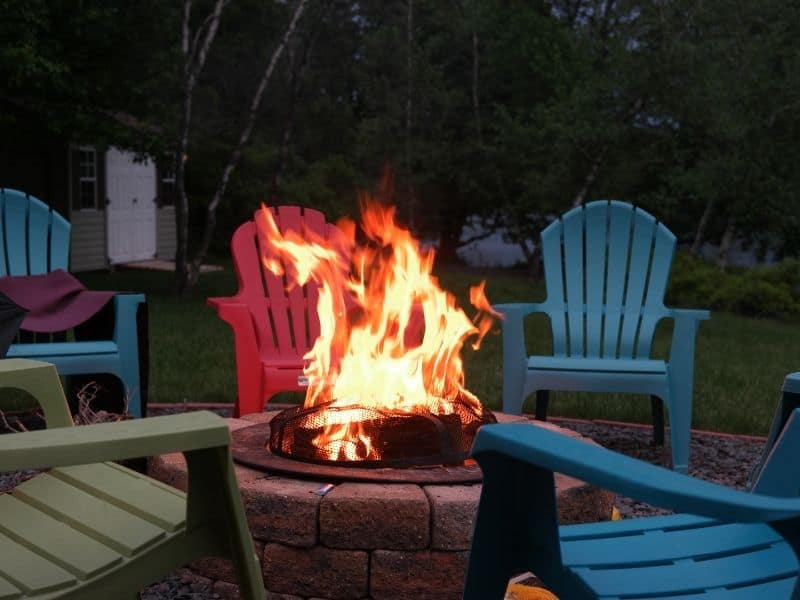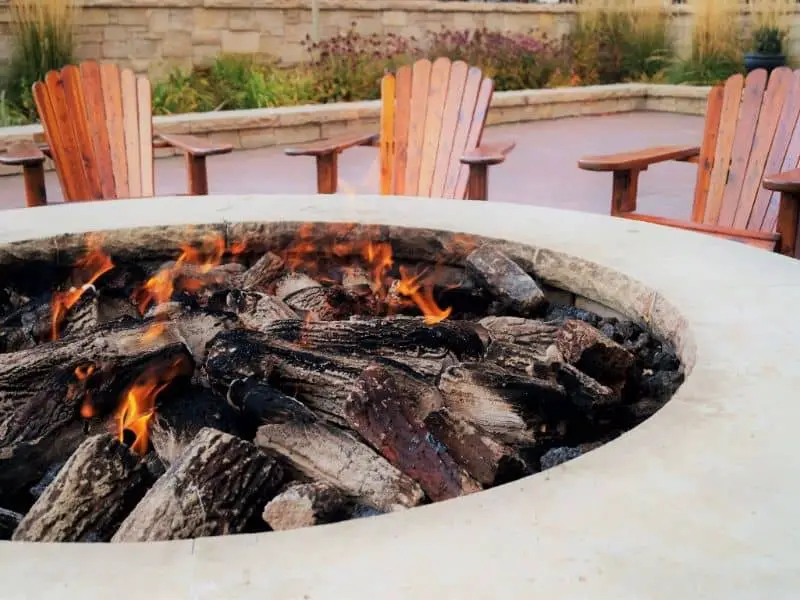Pergolas are excellent for use during the daytime when you want to enjoy the outdoors without experiencing the full power of the sun shining down on you. You can also use pergolas in the evenings, for watching the sunset, eating dinner on a comfortable night, or simply enjoying the moon and stars. But what about when the weather turns cold and you want something to provide a little heat underneath your pergola? Or perhaps you already have a built-in fire pit and you’re thinking about installing a pergola on top. Can you put a pergola over a fire pit?
Yes, you definitely can put a pergola over a fire pit, and you can do it safely. But there are several elements you must consider before doing so. Not all pergolas can facilitate a fire pit. And it’s not only the pergola that you have to consider; you must also take stock of the area surrounding the pergola, the surface on which you want to place the fire pit, general fire safety factors, the type of fuel your pit uses, and the laws specific to your area.
Read on to discover a quick guide to putting a pergola over a fire pit. Or, to put it another way, putting a fire pit under a pergola.
Local Laws and Regulations
The first thing to do before making a move on your fire pit pergola is to check your local laws and regulations. Many places have different laws when it comes to what type of fire pit you’re using.
Wood Burning Fire Pits
Wood burning fire pits can cause embers to fly out, making them dangerous in areas prone to wildfires. Burning wood can also negatively affect the air quality index, prompting many urban areas to enact burn-bans. In some places these burn bans may only be a handful of days out of the year. In others, there are only a limited number of days you’re allowed to burn wood— and this applies to burning wood anywhere— even in your indoor fireplace.
Natural Gas and Propane Fire Pits
A lot of natural gas and propane fire pits are considered “fire features,” meaning they don’t fall under the same laws as wood-burning fire pits. Both propane and natural gas burn cleaner than wood, plus they don’t produce potentially-dangerous embers. Chances are you won’t have a problem using a fire feature under your pergola, but it’s best to check local laws to be sure.
Insurance and Homeowners Associations
However, even if you do find that your city or county allows for outdoor fire pits, you’ll probably want to check with your homeowner’s insurance. Sometimes, having any kind of fire pit on your property can be in violation of your policy.
If you live in a neighborhood that has a homeowner’s association, it’s also a good idea to check with them about fire pits. Usually they’re okay if they’re not blocking a neighbor’s line of sight or posing a safety risk, but you never know until you check.
Local Guidelines for Overhead Clearance
While you’re at it, it’s a good idea to check if there are any local laws pertaining to structures above fire pits. There are some common-sense guidelines that we’ll get into below, but your local government may have guidelines unique to your area.
Ensure Proper Overhead Clearance
Once you know the legality of having a fire pit in your yard, the next big concern is overhead clearance. After all, you don’t want your pergola to become damaged by the heat, smoke, or soot coming off the fire. And you definitely don’t want it to catch on fire.
Unfortunately, there’s no hard and fast rule about this that I can tell you. For tree branches and other overhead structures, the general rule is 15-feet. However, most pergolas roofs are built only 8 or 9 feet of the ground.
You’ll want to check the gas fire pit manufacturer’s suggested overhead clearance to be sure. If you have a wood-burning fire pit that you want to put under a pergola, you can expect to get soot on your pergola slats. It’s almost unavoidable with wood smoke.
Ensure Proper Spacing

Putting a pergola over a fire pit also comes with the issue of spacing around the fire pit. For safety, you generally want to have enough clearance around the pit so that people can move around without getting too close to the fire. How close the seating is to the fire pit will depend on what type of fuel it burns, but a good rule of thumb is to keep furniture about 5-feet away from the flames.
You may want to reconsider putting a fire pit under your pergola if your pergola is right next to the house. The rule of thumb for fire pits near your house is at least 10 feet, with some places requiring a 25-foot distance. The same goes for other structures, like sheds, pool houses, or playground equipment. Again, wood fire pits are the main concern here. If you have a gas fire pit, the requirements may be different. Check local laws and the fire pit’s instructions for proper guidance.
Beware Curtains and Pergola Covers
No matter what kind of fire pit you have, you’ll definitely want to ensure that there is sufficient airflow. You never want to light any kind of fire pit in an enclosed space. You may think that, since the top of the pergola is partially open, you can close the curtains surrounding the structure, but this is never a good idea. Carbon monoxide can build up to dangerous levels in these instances.
Pergola covers are a little different. Many people have canvas pergola covers to help with direct sunlight during the day. Be aware that keeping the shade drawn over the pergola while you have a fire going may damage it. The material of your pergola itself may be tougher than the shade cover. When using a wood fire pit, it’s not advisable leaving any type of cover on the pergola, as the smoke can damage or discolor it.
Consider Your Fire Pit
We’ve mentioned briefly the different requirements and precautions each type of fire pit entails. Here we’ll go into a bit more detail, to give you the best information possible on putting a pergola over a fire pit.
Natural Gas Fire Pits
Natural gas fire pits generally need to be installed and therefore are rarely portable. These are usually used in homes that already use natural gas for heating, and they require a new line installed from the house to the fire pit. This alone makes natural gas fire pits a little more involved when it comes to pergolas.
Natural gas is a clean-burning and safe option for fire pits, and a permanent installation can make your pergola a great place to entertain or lounge. It simply takes a little more planning and money than a propane or wood fire pit.
Propane Fire Pits
Propane is a favorite for backyard fire pits. There are a ton of options on the market, big or small, that are relatively inexpensive. Propane is also clean-burning and safe. Chances are your area will have no problem with you operating a propane fire pit in your yard. Most propane pits are portable, so you can use them when you want and store them when you don’t.
Wood Fire Pits
Many people prefer wood fire pits because of the smell and the comforting noise they create. A wood fire pit is also capable of generating more heat than natural gas or propane. However, it’s not the best choice for underneath a pergola. The smoke from a wood fire will almost certainly discolor the slats of your pergola, and may even damage it if the clearance isn’t high enough.
Embers
Another thing to consider is embers from a wood fire. They can float up and get caught in the latticework. While it’s rare that this results in a fire, embers can cause unsightly damage to the pergola. If you do use a wood-burning fire pit under your pergola, it’s best to use a spark screen to mitigate some of the risk.
Upkeep
It’s entirely possible to safely use a wood fire pit under your pergola, but it’s generally more of a hassle than a gas fire pit. From repairing smoke damage, maintaining or buying a supply of firewood, cleaning ashes, and properly extinguishing the fire every time, many homeowners find a wood fire pit more than they bargained for.
Surface Damage
Wood burning fire pits can also generate enough heat to damage the surface on which they rest. If your pergola is over a wooden deck— or even a stone patio— the heat from the fire pit can warp or discolor the surface. Of course, you can always get a specially-designed item to protect your deck or patio from the heat of a fire pit.
Other Considerations
Lastly, let’s talk about some other factors to consider when putting a pergola over a fire pit.
Plants and Vines

Plants and vines are popular pergola accessories, but they can become damaged by the heat or smoke from a fire pit. If you’ve enjoyed watching those creepers make their way over the top of your pergola, you may want to think twice about using a fire pit under them. Even the little bit of heat from a gas fire pit may damage them. Although it probably won’t kill the entire plant, the section directly above the fire pit may wilt and die.
Pergola Materials and Color
Ideally, the type of materials you build your pergola with won’t be affected by the fire, due to proper clearance. Building an aluminum pergola instead of a wooden one simply because you want lower clearance is never a good idea. No matter the material, you want to ensure proper clearance.
However, some materials may be more susceptible to discoloration over time. Vinyl, for instance, may be a bad choice because you generally can’t paint over it and it eventually grows brittle when exposed to heat.
Color is another consideration. A white pergola will require more cleaning to remove soot stains than a dark-colored one, where the stains won’t be as apparent.
In Conclusion
In summation, you can put a pergola over a fire pit. Just be sure to follow your local laws, ensure proper ventilation, and check the appropriate clearance for your specific fire pit. Gas pits are the easiest and safest to use, but wood-burning fire pits can be a safe choice, as well. Of course, when dealing with fire, it’s always a good idea to follow fire safety tips and use your common sense!

